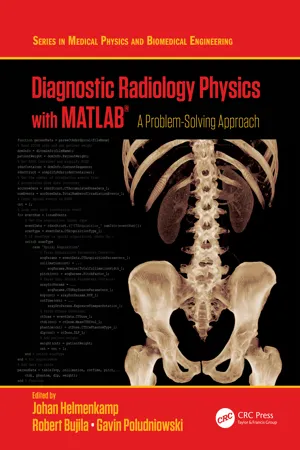
Diagnostic Radiology Physics with MATLAB®
A Problem-Solving Approach
- 272 pages
- English
- ePUB (mobile friendly)
- Available on iOS & Android
Diagnostic Radiology Physics with MATLAB®
A Problem-Solving Approach
About This Book
Imaging modalities in radiology produce ever-increasing amounts of data which need to be displayed, optimized, analyzed and archived: a "big data" as well as an "image processing" problem. Computer programming skills are rarely emphasized during the education and training of medical physicists, meaning that many individuals enter the workplace without the ability to efficiently solve many real-world clinical problems.
This book provides a foundation for the teaching and learning of programming for medical physicists and other professions in the field of Radiology and offers valuable content for novices and more experienced readers alike.
It focuses on providing readers with practical skills on how to implement MATLAB® as an everyday tool, rather than on solving academic and abstract physics problems. Further, it recognizes that MATLAB is only one tool in a medical physicist's toolkit and shows how it can be used as the "glue" to integrate other software and processes together. Yet, with great power comes great responsibility. The pitfalls to deploying your own software in a clinical environment are also clearly explained. This book is an ideal companion for all medical physicists and medical professionals looking to learn how to utilize MATLAB in their work.
Features
-
- Encompasses a wide range of medical physics applications in diagnostic and interventional radiology
- Advances the skill of the reader by taking them through real-world practical examples and solutions with access to an online resource of example code
- The diverse examples of varying difficulty make the book suitable for readers from a variety of backgrounds and with different levels of programming experience.
Frequently asked questions
Information
Applying Good Software Development Processes in Practice
- 10.1Introduction
- 10.2The trench in question: radiochromic film dosimetry
- 10.2.1General features and applications
- 10.2.2Film calibration and analysis
- 10.2.3Why treat this software as a medical device?
- 10.3An in-house software validation checklist
- 10.4Before writing the code
- 10.4.1Defining the purpose
- 10.4.2Identifying the users and their requirements
- 10.4.3The risk assessment
- 10.4.4The software design specification
- 10.4.5The development plan
- 10.4.6The validation, review and approval plan
- 10.5While writing the code
- 10.5.1Independent design review
- 10.5.2Coding, de-bugging, testing and logging
- 10.5.3Commenting
- 10.6After writing the code
- 10.6.1Developer testing
- 10.6.2User guide and supporting documentation
- 10.6.3User acceptance testing
- 10.6.4Validation against specification and final report
- 10.6.5Maintenance and software changes
- 10.7Summary of validation process and outcomes
- 10.8Regarding certification
- 10.9Conclusion
10.1Introduction
Table of contents
- Cover
- Half Title
- Series
- Title
- Copyright
- Dedication
- Contents
- SECTION I General topics
- SECTION II Problem-solving: examples from the trenches
- Index